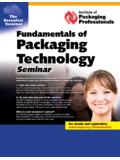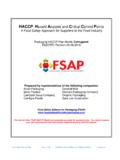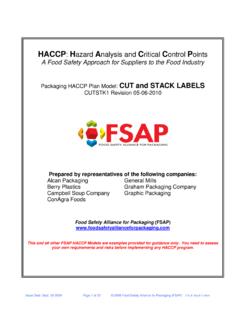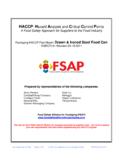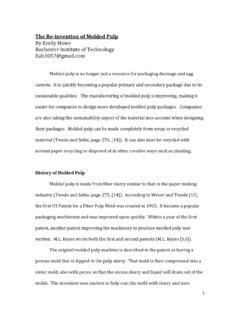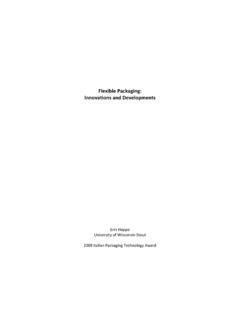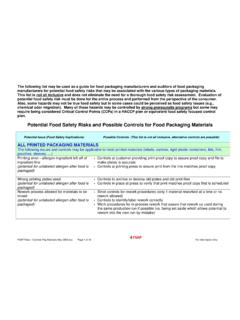Transcription of Guide to Packaging Freight Shipments - IoPP
1 1 Guide to Packaging Freight Shipments IoPP Transport Packaging Committee 2 Guide to Packaging Freight Shipments (IoPP Transport Packaging Committee Final 11/27/07 (updated 8/4/14)) Scope These guidelines are voluntary and intended to assist in designing packages and other shipping units weighing 1 51 pounds or greater, that will perform satisfactorily as single entities in a domestic or international Freight carrier environment. These guidelines are not to be considered approved carrier Packaging specifications. Following part or all of these guidelines will not guarantee the automatic approval of a damage claim by any carrier. Terminology The following terms are specific to this Guide : Performance-based: Design criteria focused on achieving a satisfactory performance to specified elements, such as degree of hazard.
2 Shipping Unit: The complete unit that will be subjected to the distribution environment, for example a crate, box, bag, pallet, or bundle capable of movement by mechanical handling equipment. Single Package: A single shipping container, including any interior protective Packaging , which provides a means of protecting and handling a product. Freight Carriers: Distribution carriers that utilize air, ocean or land to transport Shipments weighing over 1 50 pounds or Shipments that are unitized or palletized. Freight Shipment: A shipment tendered to a Freight carrier Oversize Shipment: A shipping unit exceeding the carrier's size or weight requirements. Transport Package: A shipping unit that provides containment and protection to goods during handling, storage, and transportation.
3 The term includes all industrial Packaging and the shipping containers for consumer products. Significance and Use This Guide addresses the transportation environment, which includes manual handling and the use of mechanical handling equipment. These guidelines will assist users in design and development of Packaging intended for protection of goods while they are in transit from point of origin through various Freight systems until reaching their final destination. The focus of this Guide is Shipments weighing more than 151 pounds. 3 This Guide includes domestic and international Freight parcel Shipments . Shipments of regulated hazardous materials are excluded from this Guide . If a hazardous substance is to be packaged for shipment, seek guidance from the in-house hazardous materials specialist or the carrier.
4 Additional information is available at the Department of Transportation website, http://hazmat,dot,gov, or phone 800-467-4922. This Guide is not a set of detailed material specifications and design procedures. This Guide is a listing of desired performance criteria for the transport package. Generally, the transport package addressed by the Guide will be secondary Packaging , although for some goods the transport package will be primary Packaging . The following section on "The Shipping Environment" also applies to unpackaged products (tires, spools of wire, castings, etc.) since Freight carriers transport many types of unpackaged goods. To facilitate development of proper Packaging , users of this Guide should be aware of the characteristics of package contents, including: Ability of the contents to withstand the effects of shock, compression and vibration during handling and transportation; Ability to support a load in compression Susceptibility to abrasion, moisture, corrosion, temperature, static electricity and magnetic fields.
5 The Shipping Environment The normal shipping hazards found in the Freight environment can vary by mode. Truckload, LTL, railcar, ocean and airfreight shipping environments typically include hazards that are unique to those modes as well as their common hazards, Many of the more severe hazards are due to the number of separate handlings required and the mechanized material handling equipment used. Typical Carrier Systems: Most Freight carriers rely on a "hub-and-spoke" network to cover large areas and offer fast, predictable transit times for Shipments . The hub-and-spoke system uses major sorting facilities, often called "hubs" or "depots", acting as exchange points for packages moving long distances. Hubs are designed to sort thousands of packages an hour, permitting the quick exchange and redirection of Freight .
6 Each hub is connected to a number of terminals or operating centers, which serve as home base for the local Freight delivery vehicles and where the pickup and delivery service within specific geographic areas are provided. Operating center boundaries are contiguous so that every address is covered. This system allows next-day ground service to destinations where such is possible, in this system, just because a shipment is 4 designated as a Freight package for "next-day air" does not necessarily mean it will travel in an aircraft. Within each hub or operating center, the Freight shipment may travel through the system in a variety of ways, depending on the characteristics of the Packaging and the equipment and processes utilized by that particular facility. Shipments can be classified as either regular or irregular.
7 Regular Freight Shipments are those that fall within the carrier's guidelines and are easily handled and transported without special care. Regular Package designers should check their carrier to determine the carrier's specific size and weight limits. Irregular Shipments may be: Odd or unwieldy shaped Shipments making them difficult to handle without damage Oversize with dimensions exceeding the carrier's standard limits Configured or labeled in such a way as to prohibit stacking A potential hazard to other Shipments or personnel A shipment without any type of shipping container During relatively short distance Shipments (300 miles), some carriers may load/reload packages as many as five times and handle them using multiple methods including manually and mechanically, or automatic handling, Longer distances will likely result in more loading, unloading, and sorting operations.
8 These operations present a number of hazards that could cause damage if the Packaging does not provide adequate protection. Transportation Hazards There are many possible hazards in this environment, but the five principal ones are: shock; vibration; compression; extreme climate conditions; and altitude. Shock - will occur during handling when Shipments are dropped, are struck by (or strike) other packages or objects during the sorting operation, or when they shift or fall during transit. The impacts create shock, which may cause fatigue or damage to the Packaging and their contents. Recent studies of the handling environment of Freight carriers have shown that the majority of shocks result from non free-fall impacts and that most impacts are equivalent to drops from a relatively low height.
9 Recent studies also indicate that impacts to Shipments are mostly rotational drops on edges and somewhat less on corners. Few perfect flat or perfect edge/corner drops are encountered. Most impacts occur on the bottom surface, corners or edges of the Shipments . From the package-engineering standpoint, packages should be designed to withstand shock from any direction. Due to the manual and mechanical handling methods, Freight carriers may not guarantee orientation or shock labels, or "keep upright" 5 arrows. Therefore, transit orientation may be different than the intended orientation. More likely, Freight Shipments will travel in the most stable orientation, usually the package's lowest center of gravity. This helps prevent Freight packages from falling over during the normal loading or sorting process.
10 If irregulars are handled mechanically with forklift trucks, Freight package impacts are most often the result of contact with the forklift, other Freight Shipments or the Freight shipment falling from the forklift during handling. The drop distance will depend on the height of the load being handled and the distance of the forklift blades from the surface, distances typically ranging from 4 to 48 inches. (These types of drops do not occur as frequently as impacts) Other types of impacts that occur during forklift handling include: impacts with pallets and other Freight Shipments ; impacts with fork lift blades as Freight packages bounce during handling; and impacts as Freight packages are loaded into or unloaded from trailers, trucks, Freight containers, racks or carts during sorting or transportation.
